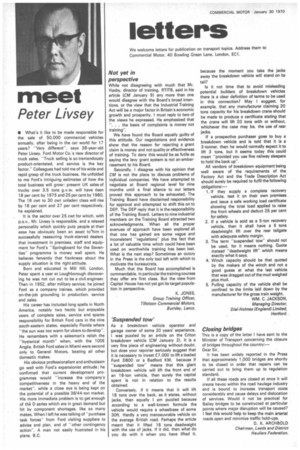'Suspended tow'
Page 32

If you've noticed an error in this article please click here to report it so we can fix it.
As a breakdown vehicle operator and garage owner of some 20 years' experience, I was puzzled by an article on the Criton breakdown vehicle (CM January 2). It is a very fine piece of engineering without doubt, but does your reporter seriously suggest that it is necessary to invest £7,000 to lift a loaded Ford D800 or a Bedford KM, because if "suspended tow" means that this giant breakdown vehicle will lift the front end of an 18-ton vehicle, then surely the capital spent is not in relation to the results obtained.
Conversely, if it means that it will lift 18 tons over the back, as it states, without jacks, then equally I am puzzled because according to a well-known formula the vehicle would require a wheelbase of some 30ft. Hardly a very manoeuvrable vehicle on the average British road. Perhaps the article meant that it lifted 18 tons deadweight with the use of jacks. If it did, then what do you do with it when you have lifted it, because the moment you take the jacks away the breakdown vehicle will stand on its tail?
Is it not time that to avoid misleading potential builders of breakdown vehicles there is a clear definition of terms to be used in this connection? May I suggest, for example, that any manufacturer claiming 20 tons capacity for his breakdown crane should be made to produce a certificate stating that the crane will lift 20 tons with or without, whichever the case may be, the use of rear jacks.
If a prospective purchaser goes to buy a breakdown vehicle and is told that it is a 3-tonner, then he would normally expect it to lift 3 tons, but it seems today this could mean "provided you use five railway sleepers to hold the back up-.
All vendors of breakdown equipment being well aware of the requirements of the Factory Act and the Trade Description Act should surely be required to fulfil the following obligations:
1. If they supply a complete recovery vehicle, test it on their own premises and issue a safe working load certificate showing the total load applied to raise the front wheels and deduct 25 per cent for safety.
2. If a vehicle is sold as a 5-ton recovery vehicle, then it shall have a 5 tons deadweight lift over the rear tailgate with adequate safety margin.
3. The term "suspended tow" should not be used, for it means nothing. Quote instead "deadweight lift" which means exactly what it says.
4. Winch capacity should be that quoted by the makers of the winch and not a good guess at what the last vehicle that was dragged out of the mud weighed plus mud.
5. Pulling capacity of the vehicle shall be confined to the limits laid down by the manufacturer for the gross train weight. WM. C. JACKSON, Managing Director, Dial-Holmes (England) Limited, Hertford.






























































































